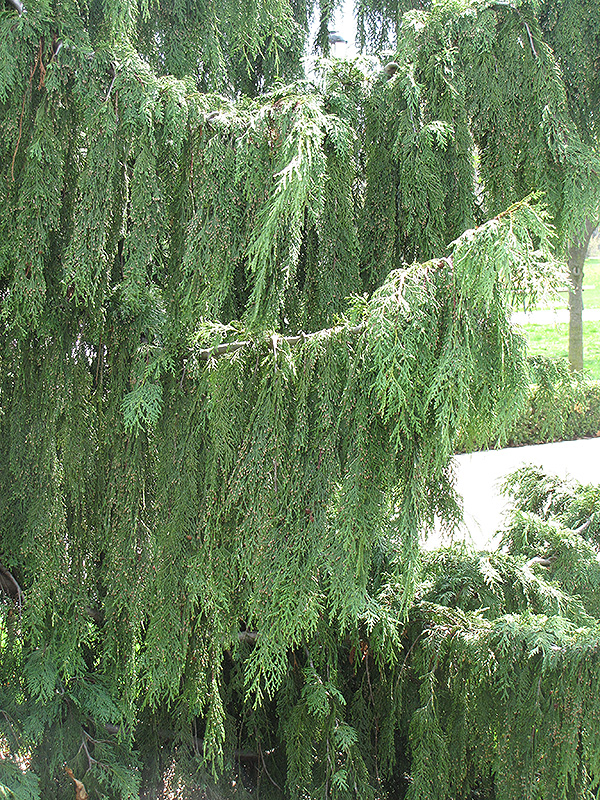
The range spans from the Kenal Peninsula in Alaska, southward to the Klamath Mountains of northern California. The Nootka cypress tree has a very limited growing range that occurs on the west coast of North America. The fungus tends to persist in areas that have warm soil temperatures that are quite moist. This is a soil-borne fungal disease that is caused by the fungus Phytophthora sojae. Nootka cypress trees are particularly susceptible to phytophthora root and stem rot. This has resulted in the mortality of nearly 7% of trees in those regions, and the numbers are only going up. Since climate change is drastically changing annual temperatures, the snowpack has become much thinner (due to less precipitation) and therefore the roots are no longer protected from the freezing temperatures. This is because trees in that region are very dependent on super heavy snowpack that helps insulate the trees’ shallow roots in the bitter winters. In Alaska, where Nootka cypress trees are referred to as yellow cedar, are experiencing very large-scale die-offs. They have rather narrow trunks but very widely spreading branches. Nootka cypresses are tall trees, and will commonly reach heights of up to 40 meters. This widespread helps protect the tree against storms and windthrow.īecause cypress trees tend to grow in areas that are very moist, much like the west coast of North America, they do not need to develop taproots in order to access moisture reserves deep in the earth. They do not grow very deep into the soil, but they will grow more widely than the spread of the crown. What do Nootka Cypress Trees Look Like? Root SystemĬypress roots tend to develop very wide and laterally spreading root systems. This is why the Nootka has foliage smooth like a woman’s hair, and why the trunk is smooth like a woman’s body. The women eventually turned into Nootka trees, and this is why the Nootka grows where it does. The raven took its chance to grab their unattended salmon, while the women got lost up in the mountains. The women, now scared, ran up the side of the mountain to hide from the owl call, leaving their drying salmon unattended. The raven flew away and hid in the trees and began to imitate the call of an owl. The women all said that they were afraid of owls, which gave the trickster raven an idea. Were they afraid of bears? Of wolves? Of being alone?Įach of the 3 women said no to all of the raven’s questions until the raven asked if they were afraid of owls. The raven went on to ask the women what they were afraid of. It is said that a raven came upon 3 young women who were busy drying salmon on a beach. With a tree so majestic and unique looking, it surely has a special story behind it. There is a legend from the Hesquiaht First Nations community that describes the origins of the Nootka cypress tree. Related: Arizona Cypress Tree | Patagonia Cypress TreeįAQs The Origin Story of the Nootka Cypress No matter how small, large, exotic, or local, we have much to learn about the tree community. If you’re feeling curious about some other trees, look no further than right here! We’ve compiled a crazy list of 101 Types of Trees from all over the world. However, not everyone agrees with this placement as the morphology of the trees’ cones are far more similar to trees found in the genus Cupressus. The Nootka cypress was originally placed in the genus Cupressus but was then moved to the genus Chamaecyparis because of the similar flattened foliage sprays as the genus. That may not seem particularly old compared to say the Bristlecone pine tree, but it is considering that the average life expectancy of Nootka cypress trees is only 70 years! The Caren range that can be found in British Columbia is where the oldest Nootka cypress tree grows. This conifer evergreen tree is native to only the coastal regions of northwestern North America.

The epithet nootkatensis comes from the First Nations people of Vancouver Island, British Columbia, that goes by the name Nuu-chah-nulth. They are also referred to as the yellow cypress, weeping cypress, weeping Nootka cypress, weeping Alaskan cedar, Alaskan cypress, Alaskan cedar, Nootka cedar, yellow cedar, and finally, the Alaskan yellow cedar. The Nootka cypress tree goes by many names. Cupressus Nootkatensis/ Chamaecyparis Nootkatensis ‘Pendula’


 0 kommentar(er)
0 kommentar(er)
